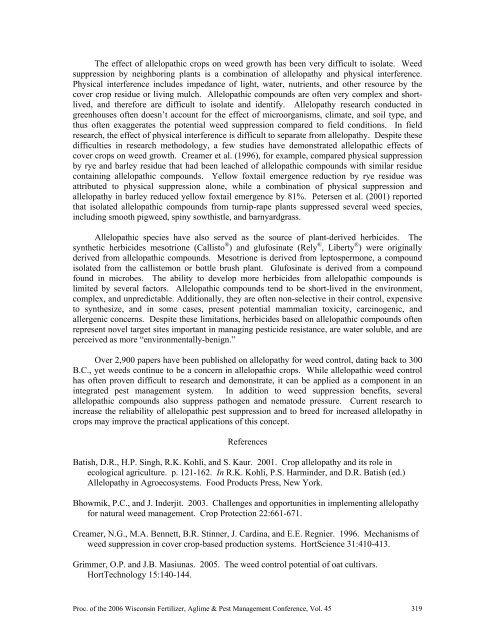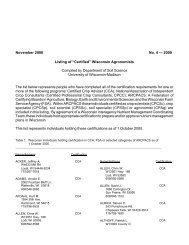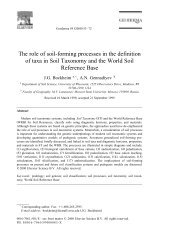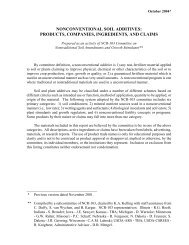ALLELOPATHY IN WEEDS AND CROPS: MYTHS AND FACTS Jed ...
ALLELOPATHY IN WEEDS AND CROPS: MYTHS AND FACTS Jed ...
ALLELOPATHY IN WEEDS AND CROPS: MYTHS AND FACTS Jed ...
Create successful ePaper yourself
Turn your PDF publications into a flip-book with our unique Google optimized e-Paper software.
The effect of allelopathic crops on weed growth has been very difficult to isolate. Weed<br />
suppression by neighboring plants is a combination of allelopathy and physical interference.<br />
Physical interference includes impedance of light, water, nutrients, and other resource by the<br />
cover crop residue or living mulch. Allelopathic compounds are often very complex and shortlived,<br />
and therefore are difficult to isolate and identify. Allelopathy research conducted in<br />
greenhouses often doesn’t account for the effect of microorganisms, climate, and soil type, and<br />
thus often exaggerates the potential weed suppression compared to field conditions. In field<br />
research, the effect of physical interference is difficult to separate from allelopathy. Despite these<br />
difficulties in research methodology, a few studies have demonstrated allelopathic effects of<br />
cover crops on weed growth. Creamer et al. (1996), for example, compared physical suppression<br />
by rye and barley residue that had been leached of allelopathic compounds with similar residue<br />
containing allelopathic compounds. Yellow foxtail emergence reduction by rye residue was<br />
attributed to physical suppression alone, while a combination of physical suppression and<br />
allelopathy in barley reduced yellow foxtail emergence by 81%. Petersen et al. (2001) reported<br />
that isolated allelopathic compounds from turnip-rape plants suppressed several weed species,<br />
including smooth pigweed, spiny sowthistle, and barnyardgrass.<br />
Allelopathic species have also served as the source of plant-derived herbicides. The<br />
synthetic herbicides mesotrione (Callisto ® ) and glufosinate (Rely ® , Liberty ® ) were originally<br />
derived from allelopathic compounds. Mesotrione is derived from leptospermone, a compound<br />
isolated from the callistemon or bottle brush plant. Glufosinate is derived from a compound<br />
found in microbes. The ability to develop more herbicides from allelopathic compounds is<br />
limited by several factors. Allelopathic compounds tend to be short-lived in the environment,<br />
complex, and unpredictable. Additionally, they are often non-selective in their control, expensive<br />
to synthesize, and in some cases, present potential mammalian toxicity, carcinogenic, and<br />
allergenic concerns. Despite these limitations, herbicides based on allelopathic compounds often<br />
represent novel target sites important in managing pesticide resistance, are water soluble, and are<br />
perceived as more “environmentally-benign.”<br />
Over 2,900 papers have been published on allelopathy for weed control, dating back to 300<br />
B.C., yet weeds continue to be a concern in allelopathic crops. While allelopathic weed control<br />
has often proven difficult to research and demonstrate, it can be applied as a component in an<br />
integrated pest management system. In addition to weed suppression benefits, several<br />
allelopathic compounds also suppress pathogen and nematode pressure. Current research to<br />
increase the reliability of allelopathic pest suppression and to breed for increased allelopathy in<br />
crops may improve the practical applications of this concept.<br />
References<br />
Batish, D.R., H.P. Singh, R.K. Kohli, and S. Kaur. 2001. Crop allelopathy and its role in<br />
ecological agriculture. p. 121-162. In R.K. Kohli, P.S. Harminder, and D.R. Batish (ed.)<br />
Allelopathy in Agroecosystems. Food Products Press, New York.<br />
Bhowmik, P.C., and J. Inderjit. 2003. Challenges and opportunities in implementing allelopathy<br />
for natural weed management. Crop Protection 22:661-671.<br />
Creamer, N.G., M.A. Bennett, B.R. Stinner, J. Cardina, and E.E. Regnier. 1996. Mechanisms of<br />
weed suppression in cover crop-based production systems. HortScience 31:410-413.<br />
Grimmer, O.P. and J.B. Masiunas. 2005. The weed control potential of oat cultivars.<br />
HortTechnology 15:140-144.<br />
Proc. of the 2006 Wisconsin Fertilizer, Aglime & Pest Management Conference, Vol. 45 319









